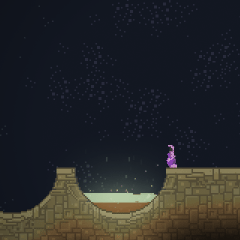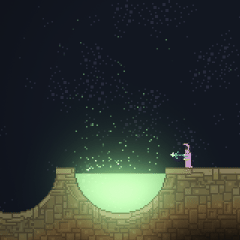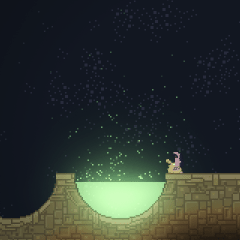Lively Concoction
Lively Concoction, often shortened to LC, is an elusive Magical Liquid. It appears as a glowing, lime-green healing liquid.
Similarly to Alchemic Precursor, it can only be obtained by mixing three different materials together, depending on the run's game seed.
Characteristics
When touched or consumed, Lively Concoction provides the ![]() Regeneration effect, constantly regaining health while active. Drinking from a Potion will grant 7.5 seconds of the effect, while staining grants it indefinitely as long as it's applied. The latter, similarly to Ambrosia's
Regeneration effect, constantly regaining health while active. Drinking from a Potion will grant 7.5 seconds of the effect, while staining grants it indefinitely as long as it's applied. The latter, similarly to Ambrosia's ![]() Protection from all, quickly wears off when moving.
Protection from all, quickly wears off when moving.
Unlike Healthium, the liquid does not disappear on contact and therefore being easier to stain. However, the liquid itself has a lifetime of 15 seconds (900 frames), vanishing soon after. It also disappears when unloaded.
Sources
- A recipe consisting of 3 random ingredients will be chosen based on the run seed.
- Rare chance of finding a
 Lively Concoction in a Treasure Chest or Great Treasure Chest.
Lively Concoction in a Treasure Chest or Great Treasure Chest.
Tips
- When using it to stain yourself, make sure to do it in a safe area and with a small hole in the ground so it doesn't spill out.
- It's recommended to store some in a flask and attempt to trigger a Fungal Reality Shift to convert other materials into more Lively Concoction. If luck is on your side, you could have a reliable, potentially infinite source of percentage based healing.
- Alternatively, Sea of Mimicium can effectively duplicate large quantities at any time.
Reactions
Lively Concoction reacts with Purifying Powder to produce Gunpowder. However, this is not exactly Healthium but an alchemical reaction between a substance with the [regenerative] tag and Purifying Powder.
Inherits additional reactions with the [water] tag that are not listed here.
| Reaction Rate | Reagents | Products |
|---|---|---|
| 80 | Purifying Powder + Lively Concoction | Gunpowder (Unstable) + Gunpowder (Unstable) |
| 70 | [lava] + Lively Concoction | [lava] + Healium |
Gallery

See Also
History
- Oct 11 2019: The [regenerative] tag was added.
| |||||||||||||||||


